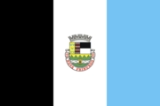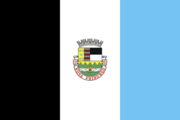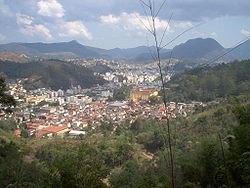
Nova Friburgo
Encyclopedia

Rio de Janeiro (state)
Rio de Janeiro is one of the 27 states of Brazil.Rio de Janeiro has the second largest economy of Brazil behind only São Paulo state.The state of Rio de Janeiro is located within the Brazilian geopolitical region classified as the Southeast...
in southeastern Brazil
Brazil
Brazil , officially the Federative Republic of Brazil , is the largest country in South America. It is the world's fifth largest country, both by geographical area and by population with over 192 million people...
. It is located in the northern mountainous region of the state, 136 km from its capital Rio de Janeiro (city). The town is 846m (2,776 feet) above sea level and encompasses a total area of 938.5 km² (362.4 mi²).
Commonly referred to as just "Friburgo", the town has an estimated population of 178,102 people, known as "Friburguenses". It was settled by 2,006 Swiss
Switzerland
Switzerland name of one of the Swiss cantons. ; ; ; or ), in its full name the Swiss Confederation , is a federal republic consisting of 26 cantons, with Bern as the seat of the federal authorities. The country is situated in Western Europe,Or Central Europe depending on the definition....
emigrants from the canton of Fribourg
Canton of Fribourg
The Canton of Fribourg is a canton of Switzerland. It is located in the west of the country. The capital of the canton is Fribourg. The name Fribourg is French, whereas is the German name for both the canton and the town.-History:...
, transferred to the region by royal decree from D. João VI in 1818, and was also the first town in the country to be settled by Germans.
Germany
Germany , officially the Federal Republic of Germany , is a federal parliamentary republic in Europe. The country consists of 16 states while the capital and largest city is Berlin. Germany covers an area of 357,021 km2 and has a largely temperate seasonal climate...
It contains the districts of Riograndina, Campo do Coelho, Amparo, Conselheiro Paulino, Lumiar and São Pedro da Serra.
History

Prince Regent
A prince regent is a prince who rules a monarchy as regent instead of a monarch, e.g., due to the Sovereign's incapacity or absence ....
John VI of Portugal
John VI of Portugal
John VI John VI John VI (full name: João Maria José Francisco Xavier de Paula Luís António Domingos Rafael; (13 May 1767 – 10 March 1826) was King of the United Kingdom of Portugal, Brazil and the Algarves (later changed to just King of Portugal and the Algarves, after Brazil was recognized...
issued a decree allowing the Swiss representative of the Canton of Fribourg
Canton of Fribourg
The Canton of Fribourg is a canton of Switzerland. It is located in the west of the country. The capital of the canton is Fribourg. The name Fribourg is French, whereas is the German name for both the canton and the town.-History:...
, Sebastian Nicolau Gachet, to establish a colony in Cantagalo. The purpose of this was to further encourage development within the Kingdom of Brazil
The United Kingdom of Portugal, Brazil, and the Algarve
The United Kingdom of Portugal, Brazil and the Algarves was a monarchy consisting of the kingdoms of Portugal, Brazil and the Algarve, as well as colonial possessions of the Portuguese Empire.-Establishment:...
and the area was chosen as it greatly resembled Swiss climate and geographical features. 100 Swiss families were to settle in the Fazenda do Morro Queimado (Farm of the Burnt Hill) where the colony of Nova Friburgo was later founded. From 1819-1820 a total of 261 families formed the original settlement nucleus and on the 17 April 1820 the government elevated its status to that of a village
Village
A village is a clustered human settlement or community, larger than a hamlet with the population ranging from a few hundred to a few thousand , Though often located in rural areas, the term urban village is also applied to certain urban neighbourhoods, such as the West Village in Manhattan, New...
.
Following the Proclamation of Brazil’s Independence (1822) the Imperial Government continued a policy of populating the nation by attracting Europe
Europe
Europe is, by convention, one of the world's seven continents. Comprising the westernmost peninsula of Eurasia, Europe is generally 'divided' from Asia to its east by the watershed divides of the Ural and Caucasus Mountains, the Ural River, the Caspian and Black Seas, and the waterways connecting...
an colonisation
Colonisation
Colonization occurs whenever any one or more species populate an area. The term, which is derived from the Latin colere, "to inhabit, cultivate, frequent, practice, tend, guard, respect", originally related to humans. However, 19th century biogeographers dominated the term to describe the...
. 80 German
Germans
The Germans are a Germanic ethnic group native to Central Europe. The English term Germans has referred to the German-speaking population of the Holy Roman Empire since the Late Middle Ages....
families led by Pastor Frederick Sauerbronn, previously assigned to settlements in the Province of Bahia
Bahia
Bahia is one of the 26 states of Brazil, and is located in the northeastern part of the country on the Atlantic coast. It is the fourth most populous Brazilian state after São Paulo, Minas Gerais and Rio de Janeiro, and the fifth-largest in size...
, ended up in Nova Friburgo on the 3rd and 4 May 1824 and were warmly welcomed. Similar arrivals of Italians, Portuguese
Portuguese people
The Portuguese are a nation and ethnic group native to the country of Portugal, in the west of the Iberian peninsula of south-west Europe. Their language is Portuguese, and Roman Catholicism is the predominant religion....
and a minority of Syrians
Demographics of Syria
Syrians today are an overall indigenous Levantine people. While modern-day Syrians are commonly described as Arabs by virtue of their modern-day language and bonds to Arab culture and history...
led to such population increases that the once village was elevated to city status
City status
City status is the national recognition of an area as a city. Specifically, "city status" may refer to:*City rights in the Low Countries*City status in Ireland*City status in the United Kingdom*City status in the United States of America...
on 8 January 1890.
Agriculture
Agriculture
Agriculture is the cultivation of animals, plants, fungi and other life forms for food, fiber, and other products used to sustain life. Agriculture was the key implement in the rise of sedentary human civilization, whereby farming of domesticated species created food surpluses that nurtured the...
was the basis of economic activity until 1910. The arrival of industrialists such as Julius Arp, Maximilian Falck e William Peacock Denis pioneered the development of an industrial sector still thriving to the present day. Of similar importance was the settlement’s relative proximity to Niteroi
Niterói
Niterói is a municipality in the state of Rio de Janeiro, southeast region of Brazil. It has an estimated population of 487,327 inhabitants and an area of ², being the sixth most populous city in the state and the highest Human Development Index. Integrates the Metropolitan Region of Rio de...
and Rio de Janeiro
Rio de Janeiro
Rio de Janeiro , commonly referred to simply as Rio, is the capital city of the State of Rio de Janeiro, the second largest city of Brazil, and the third largest metropolitan area and agglomeration in South America, boasting approximately 6.3 million people within the city proper, making it the 6th...
and improvement of transport and communication links such as the paved roads and telegraphs. This encouraged a small tourist industry to grow which, together with local commerce, became the main source of income for Friburguenses.
Nova Friburgo was affected by the 2011 Brazilian floodsJanuary 11th, with mudslides causing at least 820 deaths,and more than 200 people missing.The biggest natural disaster in the history of Brazil.The city was devastaded by a Dam
Dam
A dam is a barrier that impounds water or underground streams. Dams generally serve the primary purpose of retaining water, while other structures such as floodgates or levees are used to manage or prevent water flow into specific land regions. Hydropower and pumped-storage hydroelectricity are...
flood and the population was left with no water, electricity, food or gas.
Demographics
- Total Population: 178,102 people
- Urban: 151,820
- Rural: 21, 501
- Male: 84,248
- Female: 89,073
The population density
Population density
Population density is a measurement of population per unit area or unit volume. It is frequently applied to living organisms, and particularly to humans...
is 182.56/km² (472.8/mi²).
Schools
- Colégio Anchieta
- Colégio Estadual Canadá
- Colégio Modelo
- Colégio Nossa Senhora das Dores
- Colégio Nossa Senhora das Graças
- Colégio Nossa Senhora das Mercês
- Escola Fribourg
- Externato Santa Ignez
Universities
- Faculdade de Filosofia Santa Dorotéia - FFSD
- Universidade Candido Mendes - UCAM
- Universidade do Estado do Rio de Janeiro - UERJ (Polytechnic Institute - IPRJ)
- Universidade Estácio de Sá - UNESA
- Universidade Federal Fluminense - UFF (previously Faculdade de Odontologia de Nova Friburgo - FONF)
- Universidade Norte do Paraná - UNOPAR
Economy and industry
The city's per capita GDP was of $10.853,00 in 2006.- Manufacturing/wholesale/retail of female underwear and lingerie. Friburgo is known as the 'National Capital of Lingerie' for the size and variety of its production(around R$600 million). Local brands are beginning to compete in the international market (exports worth $4.6 million)
- Textile mills
- Metallurgic industries
- Tourism
- Floriculture (second largest producer of flowers in BrazilBrazilBrazil , officially the Federative Republic of Brazil , is the largest country in South America. It is the world's fifth largest country, both by geographical area and by population with over 192 million people...
). - Service sector, responsible for the majority of the city's GDP.
Tourism
- The region presents a well diversified combination of historical sites reflecting the colonization by Swiss and German immigrants. This coexists with mountains and Atlantic rainforest.
- On the way to Nova Friburgo through RJ-116 road, your first contact with the people and with the characteristics of this city happens when you pass by Mury, an area that precedes by 7 km the downtown part of Friburgo. Mury plays the role of a welcome mat as it introduces to the visitor a first contact with the alpine architecture and environment, under the influence of the immigrants and present on many houses,hotels and stores, such as Hotels Bucksy, Garlipp and also at a small shopping center called Mury Shopping,which also happens to house the German restaurant which serves the largest quantity of beers available in Brazil- Bräun & Bräun - a perfect recreation of a Swiss-German environment .
Mury became a sophisticated center for gastronomy in the region and offers the best German style food, Swiss raclettes, fondues, and Brazilian style barbecues. Also Mury has the best hand craft stores, and underwear (lingerie), a trade mark of all this region.
Moving forward, a detour to RJ 142 provides access to Lumiar and São Pedro da Serra.
- To facilitate moving around in the area, it is convenient to obtain information locally on the so-called regional Circuits which serve as a guide to different visiting/eating/shopping alternatives.
- In the heart of the most protected environment area, is Macae de Cima forest. Beautiful mountains and gorgeous views of the Serra do Mar (Sea Mountains Chain), is an invitation to enjoy the Atlantic Forest in its natural status.As the second biggest forest area in the Rio de Janeiro state, in Macae de Cima we find the best nature expression.Also we can see the Macae River, rising in the forest and going to the sea, very far away, on the Rio de Janeiro coast.
- The rural life of Ponte Branca - walk on the rural properties, visit the trout tanks, animals and plantations; go fishing on beautiful rivers, or riding a horse;Everything according rules of International Institute of Popular Sports ( IVV/IRCODE)
- In the heart of the Macae de Cima Reservation, a part of the Atlantic Forest, you will find the ideal landscape for walking, adventures, sports.
- The Cão Sentado (a stone shaped as a seated dog) then, from the high level of those 1.111 meters, you will be able to see the yellow, green, blue and red flowers of the trees and plants which belong to this region.
- Located on the mountains of Macae de Cima Forest (environment protected area), are the cities of Mury, Lumiar and Sao Pedro. Distant only four km from each other, and only minutes from Nova Friburgo, these cities offer you many attractions as waterfalls, valleys and mountains. During the day, walking, hiking, canoeing, horse riding through the rivers, valleys, ponds, and rivers beaches; at night the charming presence of restaurants, and small shops, inviting you to a relaxing amusement.Sao Pedro city offers you also valleys and mountains. By car or bus, from the bus terminal of Nova Friburgo, go to direction the cities of Lumiar and São Pedro da Serra, 35 km far from the center of Nova Friburgo.
- Lumiar and São Pedro da Serra are located in the forest of Rio de Janeiro, around 700 meters high. Weather is very nice in the summer, and intense cold in the winter. Near the forest of Macaé de Cima, where Mace river is born, cutting the area of Macaé. This river is responsible for the big amount of waterfalls in the region. The tranquility and peace of the veillages of Swiss colonizing, the nice weather ,forests and waterfalls, are the ingredients more attractives to take us to these two villages.
- This region began by immigrants occupation, of the Macae river shores. Lumiar was a farm owned by Portuguese Felipe de Roure, who named the village Lumiar in honor to his wife Michaella, place where she was born in Portugal. Lumiar center, park Marchon, places the old house of this family, today a commercial space.
In Lumiar there are stores restaurants, bars, delikatessen, live music, hand crafts stores, and the famous trout of the rivers. Next to the central park is the São Sebastian church, built 1901. São Pedro da Serra, distant 5 km from Lumiar hás its name because of D Pedro II emperor of Brazil. Simple design church, hosts the famous June party for Saint Sebastian, a famous event to the region.
- The João Heringer park, and the Rodrigues Alves street are the center of social life in São Pedro, where everything happens. The hand crafts done in the “ ateliês”, restaurants, bars, fondues and chocolates, besides the tranquility of the region attracts people from every place to these small villages.
Sports
- Friburguense Atlético ClubeFriburguense Atlético ClubeFriburguense Atlético Clube, or Friburguense as they are usually called, is a Brazilian football team from Nova Friburgo in Rio de Janeiro, founded on March 14, 1980.Home stadium is the Eduardo Guinle stadium, capacity 10,000.-History:...
is the most famous football (soccer)Football (soccer)Association football, more commonly known as football or soccer, is a sport played between two teams of eleven players with a spherical ball...
club of the city. The team plays at Eduardo Guinle stadiumEstádio Eduardo GuinleEstádio Eduardo Guinle is a multi-use stadium located in Nova Friburgo, Brazil. It is used mostly for football matches and hosts the home matches of Friburguense Atlético Clube, Deportivo La Coruña Brasil Futebol Clube and Santa Cruz Futebol Clube. The stadium has a maximum capacity of 12,000...
.

